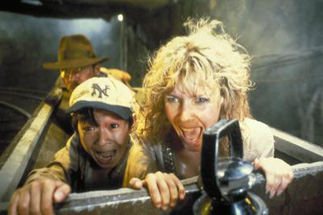Chapter Two: Indiana Jones and the Temple of Doom
By Brett Beach
August 6, 2009
The first 15 minutes of Temple of Doom and the opening musical number in particular are some of Spielberg's finest work. When Kate Capshaw slinks out of the smoke on stage and "wraps" her body around the film's title card, it is electric. "Anything Goes" is a good credo for the film, as we quickly come to see, but it's the look and feel of the piece that is so dynamic. Cinematographer Douglas Slocombe shoots the scene as if he had been told to imagine Bob Fosse taking over a production number from one of Arthur Freed's MGM musicals. The rendition of the song is catchy and jazzy and upbeat. But the sequence is painted in cool blues and overwhelmingly icy blacks and it feels in its own way as chilling (but far more enticing) as the hellish underground inferno that provides the film's set pieces in the second half.
Spielberg uses the opening to set the tone for the rest of the film, as he has done masterfully for all four installments in the series so far. A case in point is the beginning of Kingdom of the Crystal Skull, which plops us efficiently down in the 1950s with a minimum of effort, achieves a tone somewhere sci-fi and noir, and via the escaping-a-nuclear-blast-by-hiding-inside-a-refrigerator trick, lets the audience cheerfully know that this will be the most absurd of all of Indiana Jones' travails. I enjoyed the rest of Crystal Skull, but felt that the opening was really the main point for all involved and the rest was just what followed after. It's like how the host of an awards show has to get things off to a pumped up start and raise the adrenaline of the audience and then more or less play traffic cop the remainder of the evening to make sure things stay the even course.
Temple of Doom is perplexing for me in that it is obviously a prequel, taking place in 1935, a year before the events in Raiders of the Lost Ark, but the character of Indiana Jones seems far more cynical, darker and brooding this time around. These are qualities one might expect to find in a character farther down the road chronologically. The taciturn, rough and tumble but playful (and slightly nerdy) mien from Raiders is absent. This Dr. Jones is an opportunist, kind of a sadist, most definitely a misogynist and just shy of being an all around bastard. And yet, he looks after Short Round, an orphan, and protects him fiercely when push comes to shove. Harrison Ford wisely never tries to make Indiana likable. The natural swagger of the character, his willingness to leap headfirst into ridiculous situations and Indiana's calm under fire make him inherently appealing, leaving Ford to have fun with the nastier side of the persona, which he does with understated pleasure during the portion of the plot where Indy has been put into a trance and prepares Willie Scott (Kate Capshaw) to be sacrificed.
Continued:
1
2
3
4
|
|
|
|




